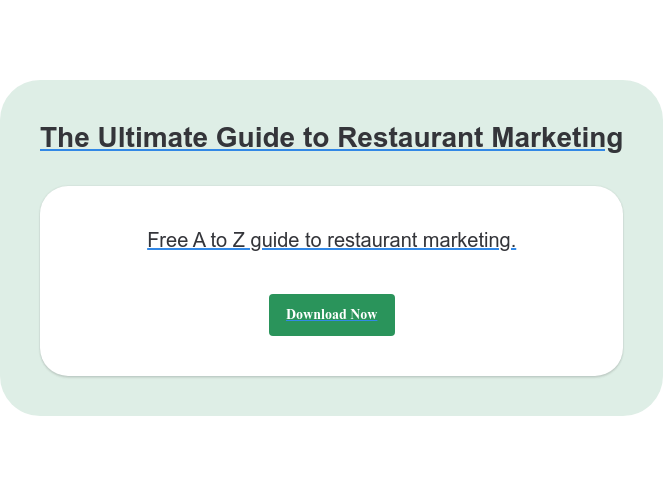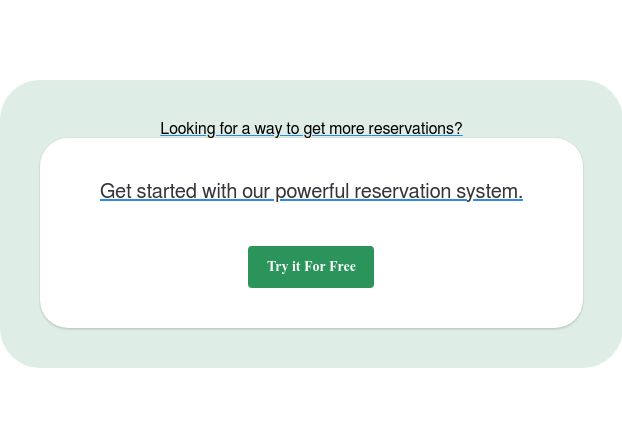The right advertising mix for your restaurant will be defined by your business goals. Whether you’re just launching, hoping to rebrand or want to get yourselves known as the destination for a particular type of food, a great marketing strategy can make a huge impact.
Traditionally, food advertising has sought to evoke the senses by focusing on the food itself. However, while food imagery still very much has a part to play, storytelling, strong branding and alignment with a particular lifestyle increasingly factor in too.
And of course, the advertising techniques you select should be guided by who your target customers are, and where you they can be found. Keep up with recent restaurant marketing ideas and trends.
From invoking a little FOMO on social media, through to creating a truly unforgettable TV advert, we’re looking at some of the best restaurant advertising campaigns of recent years and what your restaurant can learn from them.
Ruby Tuesday moms shy girl
Familiar foods can give us feelings of nostalgia and reassurance but trying something new comes with its own rewards too.
This video campaign by US casual dining chain Ruby Tuesday definitely touches on this.
The advert ‘Shy Girl’ features a little girl who has moved cities and is struggling to settle at school. In the video, she orders the same meal of mac and cheese each week during a family outing.
This is until she spots a potential new friend at the restaurant’s garden bar. The little girl decides to order the DIY salad and connects with a new friend in the process.
This emotional ad is targeted firmly at parents, positioning the brand as familiar and family-friendly.
It’s a great example of a brand aligning themselves with their target audience, their concerns and their lifestyle. It’s super cute and tugs at the heartstrings too.
Bertie’s serves up local celebs
Sometimes successful restaurant owners decide to do something new, like extending their brand by opening additional restaurants offering different types of food.
Recently-launched Bertie’s Restaurant and Bar in Edinburgh, Scotland, fits neatly into this category.
The owners, Vittoria Group, are responsible for other restaurants in the city such as Leith’s highly rated La Favorita.
If you’re launching a new venture but want to emphasize you are already part of the neighborhood, involving some local celebs is a great place to start.
You could go down the tried-and-tested route of getting them to open your restaurant, but Bertie’s decided to be a little more creative.
As part of the advertising campaign to help launch Edinburgh’s biggest and fish and chip restaurant, local football captains from sports clubs Hibs (Hibernian) and Hearts (Heart of Midlothian) David Gray and Christophe Berra featured in this light-hearted advert.
Recognizing that match day supporters are a great target audience for the restaurant, Bertie’s also reportedly offers a 20% discount for season ticket holders. So they’ve given the local football supporters a great reason to share news of their launch and to walk through the door too. 
Hapa Sushi’s humor and hashtags

Great creative is at the heart of traditional advertising, right?
Hapa Sushi’s 2016 social media campaign combined fantastic food photography with humorous copywriting for a modern campaign with a good helping of social media relevance.
The Japanese dining chain used cheeky movie-inspired dialogue alongside striking menu imagery to play on the popular social media ‘foodporn’ hashtag.
This campaign used the funny and familiar to build brand awareness on Instagram and took advantage of the huge following of #foodporn.
It’s simple but clever; we think you’ll agree.
Wu Fang Zhei’s epic storytelling
Sticky rice dumplings are a Chinese staple, so how do you make them stand out?
With this epic-style TV advert that is full of drama, fun and is ultimately very memorable. Featuring individual grains of rice on their challenging quest to become part of a Wu Fang Zhei rice dumpling, this advert is a great example of a brand demonstrating personality.
The funny storyline and powerful soundtrack make for a very entertaining and unforgettable advert. The theme also helps the restaurant to differentiate their offering in a crowded space and to become known for a particular dish.
This advert is totally bonkers but also brilliant.
Leon’s lean and clean
Leon is a medium-sized English chain restaurant with a high concentration of branches in London. You’ll find Leon in tube and train stations and shopping malls.
In 2016 the chain sought to differentiate itself from the standard fast food offerings in these locations with its ‘Lean and Clean’ campaign.
This was a relatively low-cost ad campaign that used both offline and online activity to extend the reach of the brand, which has since opened up a flurry of new sites.
Offline, the brand flyered cyclists with a free breakfast with coffee offer.
Online, they partnered with UK social media influencer Joe Wickes (@thebodycoach).
At the time, Joe had begun to make a name for himself and had a sizeable social media following thanks to his sharing of high impact workouts and meal ideas.
Leon was able to borrow his highly relevant audience through the social media marketing campaign. This included sharing Leon competitions, recipes and #leanandclean exercise videos.
The campaign also gave Joe great exposure and he’s since gone on to release his own cookbooks.
Prior to this campaign, Joe was a regular visitor to Leon restaurants and followed a lifestyle closely aligned with the brand. This advertising campaign shows the importance of building relevant and authentic influencer partnerships for success.
Applebees fantogapher customer-generated content
Encouraging diners to share their dining experience with others is a common social media marketing strategy. So much so, many restaurants commonly have photo props at the dining table or a branded Instagram frame at the restaurant entrance.
This is of course to encourage visitors to take a selfie or to share photographs of the food or dining experience. This tactic is employed with various degrees of success.
However, it’s always good to revisit why tapping into the Instagram generation’s urge to snap their meals can be a good idea.
Applebees fantographer campaign from 2014 is a fan-tastic example. Diners were tasked with taking photographs of their meals and tagging them with #Applebees or #fantographer.
The best images were then branded with a frame and re-shared by the brand.
The campaign is credited with gaining the brand 4,500 new followers on Instagram and increasing engagement levels by 25%. That’s without even considering additional potential reach.
It’s easy to see why ‘snap and share’ remains a popular social media advertising strategy.
Pizza Pilgrims’ pizza evangelists
Pizza Pilgrims has restaurants in England’s London and Oxford but the brand, which is only a few years’ old, actually started out with a pizza van in London’s Soho.
The owners relied on attracting a high volume of customers within a very small and specific geographic area.
To help with this, they worked with local social media influencers to build awareness of their brand. And instead of simply giving away freebies in exchange for exposure Pizza Pilgrims chose to involve these influencers in decisions – which cheese should they use, should this pizza be added to the menu?
As a result, local foodies became brand evangelists, spreading the word and images of Pizza Pilgrim’s delicious pizzas.
The message here is that you don’t necessarily need to be working with influencers with huge followings – just highly engaged and relevant ones.
Zizzi’s gamification

Discount vouchers can be a great way to get diners through the door. However, discounting with vouchers is already a hugely popular advertising strategy, so how do you ensure it’s your vouchers diners choose to use?
Zizzi is a UK-based Italian food chain that has taken a really creative approach to encouraging diners to engage with vouchers in the past, thanks to gamification.
The brand ran a number of game-led discount campaigns including a scratch off discount game built on the buzz of the 2015 Rugby World Cup and more recently a board game that allowed customers to obtain discount vouchers or entries to a prize draw for a holiday.
The board game encouraged regular engagement by giving participants a number of dice rolls every day.
This helped keep the brand in mind and gave them the edge over other restaurants when diners were considering eating out.
After all, if you’re sending a discount via email, there’s no guarantee of good timing. Of those who took part, 33% played for five days or more and 20% played for ten days or more.
Subway weather
We love the sunshine influenced success of Subway’s recent mobile campaign.
According to Mobile Marketer, the quick service restaurant boosted its footfall by 31% by targeting mobile ads influenced by the weather.
Artificial intelligence helped to drive dynamic ads for foot long sandwich promotions that avoided placing hot sandwich ads during heat waves.
This ad campaign recognized that weather is a huge influence on the type of food and drink people consume and also how far they’re likely to travel to eat.
You don’t need to reserve this advertising tactic solely for online use either; it could equally be used to influence digital signage. Or to take this lesson right back to basics, you can use weather forecasts to decide which specials you feature on your chalkboard at your restaurant entrance.
Which restaurant advert from our selection is your favorite?
By now your brain is probably gearing up to think of some wonderful or perhaps even whacky advertising possibilities for your restaurant.
But before you get too carried away, do be mindful that a scattergun approach could dilute your success. As a reminder, when planning out your advertising strategy, try and settle on a mix that’s targeted both on your business goals and firmly on your customer.
And once your advertising is in action, be sure to measure its effectiveness and feed what you learn back into your next advertising campaign.














.webp?width=200&name=v2-15mknc-qpw1b%20(1).webp)
.webp?width=200&name=v2-15kqni-p0exl%20(1).webp)
-1.png?width=1812&height=1072&name=TripAdvisor%20%26%20More%20Bookings%20(1)-1.png)
-2.png?width=1812&height=1072&name=Google%20Bookings%20(1)-2.png)


-1.png?width=200&name=TripAdvisor%20%26%20More%20Bookings%20(1)-1.png)
-2.png?width=200&name=Google%20Bookings%20(1)-2.png)
-1.png?width=200&name=Instagram%20Bookings%20(1)-1.png)
-1-png.webp?width=200&name=Facebook%20Integration%20Rectangle%20(1)-1-png.webp)







.webp?width=200&name=download%20(1).webp)
%20(1)-2.webp?width=200&name=Eat%20(34)%20(1)-2.webp)
%20(1)-2.webp?width=200&name=Eat%20(18)%20(1)-2.webp)





%20(1)-1.webp?width=314&height=175&name=Eat%20(45)%20(1)-1.webp)
%20(1).webp?width=314&height=175&name=Eat%20(53)%20(1).webp)
.webp?width=314&height=175&name=image19%20(1).webp)
%20(1).webp?width=314&height=175&name=Eat%20(66)%20(1).webp)


.webp?width=144&height=72&name=Eat%20App%20Logo%20(3).webp)